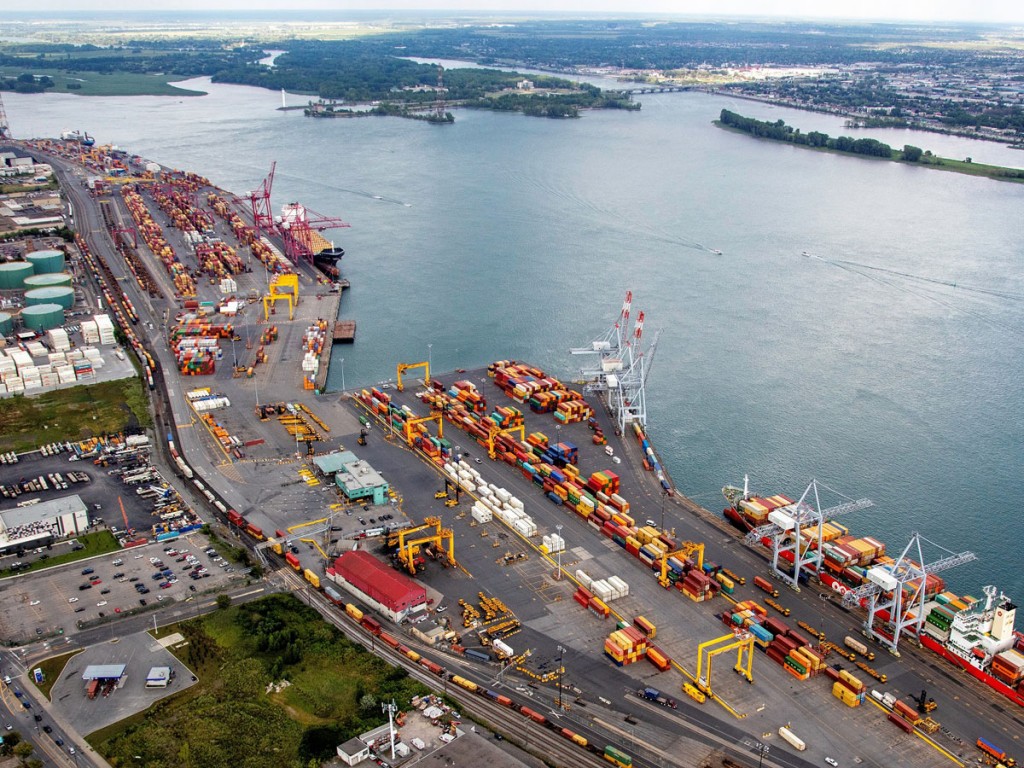As 2020 begins, there are no signs that Montreal, Canada’s second biggest port after Vancouver, strategically located deep inland in relation to the industrial heartland of North America, is slowing down in terms of both capacity and cargo expansion. Last year marked the first time the Port of Montreal surpassed 40 million metric tons in total cargo handled – with the tally attaining 40.5 million tons versus 39 million tons in 2018. And another record was set in container volume, which rose by 4.4% to 1.75 million TEUs.
“In 2020, we are projecting that container traffic could increase another 3%,” said Tony Boemi, VP growth and development at the Montreal Port Authority (MPA). In an interview, he attributed the overall cargo growth in 2019 in part to the resumption of activity at the Viterra grain terminal hit by a nine-month lockout in 2018.
“Emerging markets continue to have a positive impact on the Port of Montreal,” he continued. “This is the result of transshipment ports being used as hubs to trans-load cargo from the mega containerships to the right size vessels needed for market access.”
Indeed, emerging markets in Asia today represent 26% of Montreal’s container volume, followed by the Middle East (7%) and Latin America (5%). Europe remains the Port of Montreal’s largest maritime trading partner, although its percentage share has diminished somewhat despite the positive impact of the two-year old free trade agreement with the European Union.

The highlights on port infrastructure expansion include the work to begin in 2020 on expanding the Viau container terminal by 250,000 TEUs. Also on tap is the redevelopment of the Bickerdike Terminal that is the main base for domestic container shipments to Newfoundland and the Magdalen Islands. The capacity of the port’s rail network will be enlarged by 20%. Funding has been received from the federal government to improve truck and rail fluidity within the port area.
Finally, plans are moving forward for a major container terminal project entailing added capacity of 1.1 million TEUs at Contrecoeur, 25 miles downstream from Montreal on the St. Lawrence River, with a start-up target of 2023-2024. The terminal would boost Montreal’s total container capacity from 2.1 million TEUs to 3.2 million TEUs.
The Contrecoeur project was given a significant boost in December through the commitment of up to $300 million in financing announced by the Canada Infrastructure Bank – which implied auspicious support from the federal government in the view of some industry analysts. The port’s two leading terminal operators, MGT and Termont (Logistec group) have been holding discussions on a possible joint venture whose total cost has been estimated at between $750 million and $950 million.
“On the environmental aspect, we are moving closer to obtaining the required permits,” Ryan Dermody, VP Contrecoeur, told the American Journal of Transportation. “Following the filing of our impact study in 2018, we have been answering questions from the Impact Assessment Agency of Canada. We are hopeful to obtain the required authorizations in 2020 and we are currently preparing the detailed engineering of project which, with the necessary environmental approval, will allow us to proceed with the first phases of construction.”
MGT investing in 14 new cranes
Meanwhile, in the latest significant development, Michel Fratianni, president and CEO, of Montreal Gateway Terminals Partnership, confirmed that about $100 million is being invested in 14 state-of-the-art Liebherr cranes. Under an equipment upgrade program, ten Liebherr electric rubber-tired gantry cranes (RTGs) will be complemented in the coming two years by four ship-to-shore cranes.
“We now have the largest fleet in Canada of electric rubber-tired gantries,” he said, adding: “Collectively, MGT has, in effect, committed capital expenditures of $100 million between 2019 and 2021.”
The head of the biggest terminal operator at the Port of Montreal stressed that the investments in the energy-efficient cranes support MTG’s continuous efforts to optimize productivity and capacity at its Racine and Cast terminals while reducing carbon and nitrogen dioxide emissions.
MTG contracted longstanding partner Liebherr Container Cranes in October 2018 to deliver the ten RTGs, following the successful retrofitting of two existing RTGs with a conductor bar system allowing for full-electric operation. These cranes with a heavy-duty drive system on board were fully commissioned at the end of 2019.
The ten new cranes have a safe working load of 40.6 tons and can handle six containers plus a truck lane wide. The four ship-to-shore cranes on order will have an outreach to handle 21 containers across the deck versus 14 on existing cranes. To be delivered by Q3 2021, they will provide twin lifts capacity and 65 tons of safe weight loads.
“We believe that the time will come when ships of 21 (containers) wide will be moving up and down the St. Lawrence as opposed to 15 wide at present,” opined Fratianni. This would translate into regular calls by containerships in the 6,000 TEU range, navigating within the limits of draft restrictions coming into Montreal.

